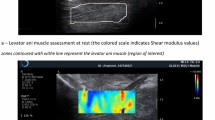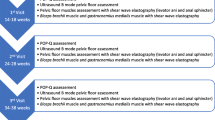Abstract
Introduction and hypothesis
We hypothesized that shear wave elastography (SWE) technology might be useful for assessing the elastic properties of the pelvic floor in women. Our primary objective was to evaluate the feasibility of assessing the levator ani muscles using SWE in women. Our secondary aim was to investigate the changes in their elastic properties from rest to Valsalva maneuver.
Methods
During this prospective feasibility study in nonpregnant female volunteers, we collected data on participant age, body mass index (BMI), parity, and time since the delivery. The levator ani muscles of each participant were assessed using SWE technology at rest and during a Valsalva maneuver by measuring the shear modulus (in kilopascals). We then assessed the changes in the shear modulus at rest and during the Valsalva maneuver using a Wilcoxon test.
Results
Twelve parous women participated in this study. The mean time since the last delivery was 14 months, the mean age was 31 years, and mean BMI was 28 kg.m−2. All the assessments performed at rest were successfully completed, but we encountered two failures during the Valsalva maneuver. The mean shear modulus increased by a factor of more than 2 from rest to the Valsalva maneuver for both the right (16.0 vs 35.4 kPa) and left side (17.1 vs 37.6 kPa).
Conclusions
An assessment of the elastic properties of the levator ani muscles is feasible for nonpregnant women. The reproducibility of the technique and its application in pregnant women and women with pelvic floor disorders must be investigated.


Similar content being viewed by others
References
Lowenstein E, Ottesen B, Gimbel H. Incidence and lifetime risk of pelvic organ prolapse surgery in Denmark from 1977 to 2009. Int Urogynecol J. 2015;26:49–55.
Wu JM, Matthews CA, Conover MM, et al. Lifetime risk of stress urinary incontinence or pelvic organ prolapse surgery. Obstet Gynecol. 2014;123:1201–6.
Gyhagen M, Bullarbo M, Nielsen TF, et al. Prevalence and risk factors for pelvic organ prolapse 20 years after childbirth: a national cohort study in singleton primiparae after vaginal or caesarean delivery. BJOG. 2013;120:152–60.
Gyhagen M, Bullarbo M, Nielsen TF, et al. The prevalence of urinary incontinence 20 years after childbirth: a national cohort study in singleton primiparae after vaginal or caesarean delivery. BJOG. 2013;120:144–51.
Gachon B, Desseauve D. Fradet L, et al. Changes in pelvic organ mobility and ligamentous laxity during pregnancy and postpartum. Review of literature and prospects. Prog Urol. 2016;26:385–94.
Gachon B, Fritel X. Fradet L, et al. Is levator hiatus distension associated with peripheral ligamentous laxity during pregnancy? Int Urogynecol J. 2017;28:1223–31.
Milsom I. Can we predict and prevent pelvic floor dysfunction? Int Urogynecol J. 2015;26:1719–23.
Wilson D, Dornan J, Milsom I, et al. UR-CHOICE: can we provide mothers-to-be with information about the risk of future pelvic floor dysfunction? Int Urogynecol J. 2014;25:1449–52.
Drusany Starič K, Bukovec P, Jakopič K, et al. Can we predict obstetric anal sphincter injury? Eur J Obstet Gynecol Reprod Biol. 2017;210:196–200.
Webb SS, Hemming K, Khalfaoui MY, et al. An obstetric sphincter injury risk identification system (OSIRIS): is this a clinically useful tool? Int Urogynecol J. 2017;28:367–74.
Meister MR, Cahill AG, Conner SN, et al. Predicting obstetric anal sphincter injuries in a modern obstetric population. Am J Obstet Gynecol. 2016;215:310.e1–7
Aydeniz A, Dikensoy E, Cebesoy B, et al. The relation between genitourinary prolapse and joint hypermobility in Turkish women. Arch Gynecol Obstet. 2010;281:301–4.
Norton PA, Baker JE, Sharp HC, et al. Genitourinary prolapse and joint hypermobility in women. Obstet Gynecol. 1995;85:225–8.
Al-Rawi ZS, Al-Rawi ZT. Joint hypermobility in women with genital prolapse. Lancet. 1982;1:1439–41.
Ashton-Miller JA, DeLancey JO. Functional anatomy of the female pelvic floor. Ann N Y Acad Sci. 2007;1101:266–96.
Dietz HP, Shek C, De Leon J, et al. Ballooning of the levator hiatus. Ultrasound Obstet Gynecol. 2008;31:676–80.
Staer-Jensen J, Siafarikas F, Hilde G, et al. Ultrasonographic evaluation of pelvic organ support during pregnancy. Obstet Gynecol. 2013;122:329–36.
Gennisson JL, Deffieux T, Fink M, et al. Ultrasound elastography: principles and techniques. Diagn Interv Imaging. 2013;94:487–95.
Hug F, Tucker K, Gennisson JL, et al. Elastography for muscle biomechanics: toward the estimation of individual muscle force. Exerc Sport Sci Re. 2015;43:125–33.
Bercoff J, Tanter M, Fink M. Supersonic shear imaging: a new technique for soft tissue elasticity mapping. IEEE Trans Ultrason Ferroelectr Freq Control. 2004;51:396–409.
Taljanovic MS, Gimber LH, Becker GW, et al. Basic physics and musculoskeletal applications. Radiographics. 2017;37:855–70.
Gennisson JL, Muller M, Gabor P, et al. Quantification of elasticity changes in the myometrium during labor using supersonic shear imaging: a feasibility study. Ultrasonics. 2015;56:183–8.
Muller M, Ait-Belkacem D, Hessabi M, et al. Assessment of the cervix in pregnant women using shear wave elastography: a feasibility study. Ultrasound Med Biol. 2015;41:2789–97.
Orno AK, Dietz HP. Levator co-activation is a significant confounder of pelvic organ descent on Valsalva maneuver. Ultrasound Obstet Gynecol. 2007;30:46–350.
Dietz HP, Shek KL. Levator defects can be detected by 2D translabial ultrasound. Int Urogynecol J Pelvic Floor Dysfunct. 2009;20:807–11.
Eby SF, Song P, Chen S, et al. Validation of shear wave elastography in skeletal muscle. J Biomech. 2013;46:2381–7.
Oliveira DA, Parente MPL, Calvo B, et al. A holistic view of the effects of episiotomy on pelvic floor. Int J Numer Method Biomed Eng. 2017;33:e2892. https://doi.org/10.1002/cnm2892.
MacDonald D, Wan A, McPhee M, et al. Reliability of abdominal muscle stiffness measured using elastography during trunk rehabilitation exercises. Ultrasound Med Biol. 2016;42:1018–25.
Lacourpaille L, Hug F, Bouillard K, et al. Supersonic shear imaging provides a reliable measurement of resting muscle shear elastic modulus. Physiol Meas. 2012;33:19–28.
Kruger JA, Budgett SC, Wong V, et al. Characterising levator-ani muscle stiffness pre- and post-childbirth in European and Polynesian women in New Zealand: a pilot study. Acta Obstet Gynecol Scand. 2017;96:1234–42.
Kruger JA, Nielsen PM, Budgett SC, et al. An automated hand-held elastometer for quantifying the passive stiffness of the levator ani muscle in women. Neurourol Urodyn. 2015;34:133–8.
Chen L, Low LK, DeLancey JO, et al. In vivo estimation of perineal body properties using ultrasound quasistatic elastography in nulliparous women. J Biomech. 2015;48:1575–9.
Silva MET, Brandao S, Parente MPL, et al. Biomechanical properties of the pelvic floor muscles of continent and incontinent women using an inverse finite element analysis. Comput Methods Biomech Biomed Engin. 2017;20:842–52.
Nordin MLT, Campello M, Nordin M, et al. In: Nordin M, Frankel VH, editors. Basic biomechanics of the musculoskeletal system. 3rd ed. Philadelphia: Lippincott Williams & Wilkins; 2001. p. 102–25.
Acknowledgements
The authors thank Dr Gregory Legrain (Institut de Recherche en Génie Civile et Mécanique, UMR CNRS 6183, Ecole Centrale de Nantes) for his valuable comments.
Author information
Authors and Affiliations
Corresponding author
Ethics declarations
Conflicts of interest
None.
Rights and permissions
About this article
Cite this article
Gachon, B., Nordez, A., Pierre, F. et al. In vivo assessment of the levator ani muscles using shear wave elastography: a feasibility study in women. Int Urogynecol J 30, 1179–1186 (2019). https://doi.org/10.1007/s00192-018-3693-4
Received:
Accepted:
Published:
Issue Date:
DOI: https://doi.org/10.1007/s00192-018-3693-4




